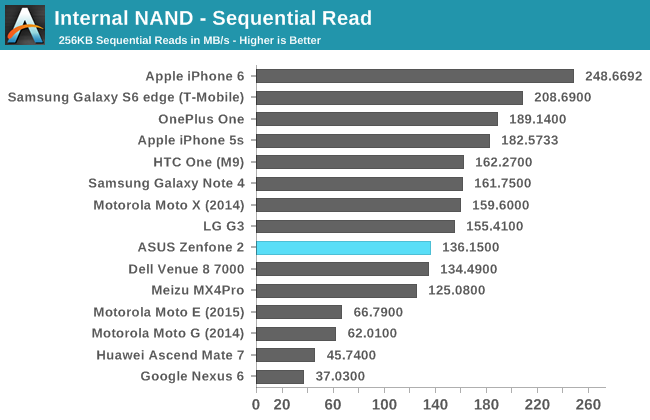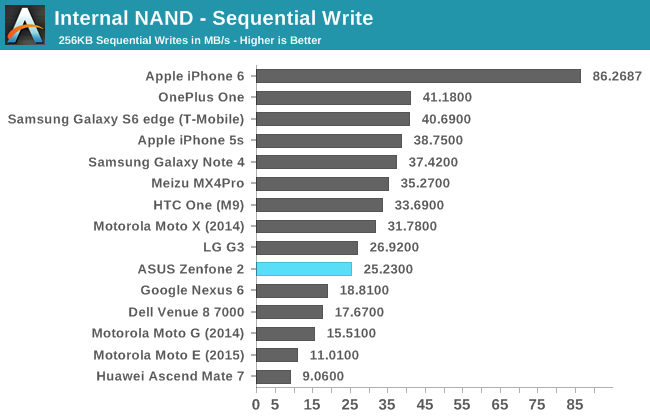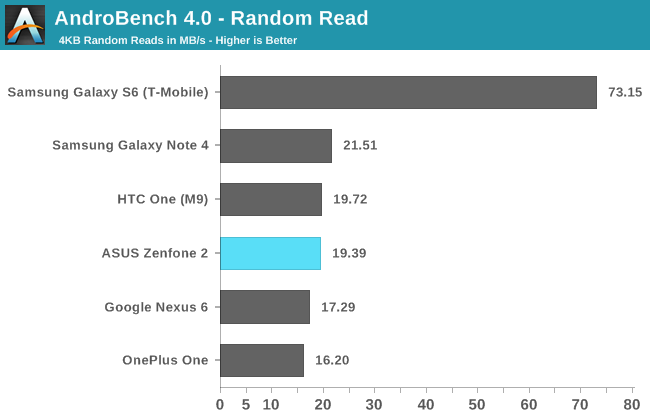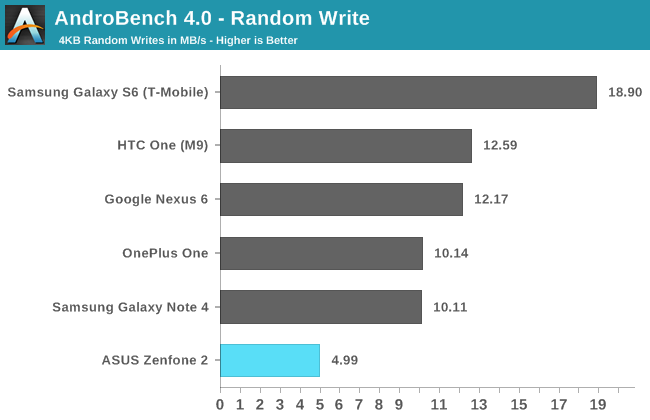The ASUS ZenFone 2 Review
by Brandon Chester on May 26, 2015 8:00 AM ESTNAND Performance
While it's not disclosed by manufacturers, the speed of NAND on a smartphone is a very important aspect of overall smartphone performance. It has an impact on how long cameras can do burst capture, and how well the phone performs when apps are running both in the foreground and the background. To evaluate the NAND performance of the ZenFone 2 I've run it through both of our internal storage benchmarks. Because our iOS benchmark only supports a single IO thread, we'll be using our older storage benchmark alongside the newer Androbench 4.0 test for the foreseeable future.




In our original single threaded storage benchmark the ZenFone 2 is decidedly average in its performance. In every case it's either slightly above or below the median result on our charts. It's important to keep in mind that this test puts devices like the Galaxy S6 with its UFS storage at a disadvantage, as its NAND can make use of several IO threads due to the use of a command queue.




In our newer AndroBench 4.0 storage test we see that the ZenFone 2 ends up falling farther behind the other devices that we've run through the test. In the sequential read test it's not the slowest device, but that's only due to the Nexus 6 being extremely far behind every other device as a result of Google's full disk encryption. In the sequential write and random read tests it's comes behind the HTC One (M9), although to a very small degree in the latter test. Random writes are where it really stumbles, with a speed that's less than half of the next slowest device.
I'm not sure whether I can attribute it to the enormous amount of RAM that the 4GB version of the ZenFone 2 can use as a cache, but I never noticed any issues with performance as a result of IO operations being run either by the app I was using or by another application in the background. Even when updating applications, performance remained consistent.










147 Comments
View All Comments
blzd - Thursday, May 28, 2015 - link
That makes sense as Google released an update specifically for the Nexus 6 to have all 4 cores run at the same time during normal phone operations.Apparently it brought snappier performance at the cost of slight battery reduction.
As usual though, battery improvements tend to be placebo.
tipoo - Tuesday, May 26, 2015 - link
Everyone was quick to blame the Intel SoC and the alleged x86 power penalty, but this looks like pretty good proof they just picked an inefficient display panel.Though it could still have something to do with the SoC - the review also noticed the screen backlight adjustment to the colors on screen was rather aggressive, that's an Intel technology for saving power. I wonder if other SoCs are just better at it. Less noticable, while saving more power?
epr118 - Tuesday, May 26, 2015 - link
Hey Brandon, you mention the double tap to wake, but the phone also has a double tap to shut off the screen. You just need to be on the home screen and not in an app for it to work.icwhatudidthere - Tuesday, May 26, 2015 - link
You can be in an app, you just have to double tap on the notification bar.epr118 - Tuesday, May 26, 2015 - link
Ah, I never tried that. Thanks for the tip!Brandon Chester - Tuesday, May 26, 2015 - link
I was unaware of this, thanks for the tip.shadowjk - Tuesday, May 26, 2015 - link
I'm curious how long the battery would last streaming Spotify or similar over mobile network. This is a use case where the inefficient screen doesn't matter as much. Would be interesting to see if the CPU can service that without staying awake constantly burning loads of power, and how power efficient the modem is.My current device doesn't last 8 hours streaming music, and I need to carry powerbanks to keep it fed.
tipoo - Tuesday, May 26, 2015 - link
"Because our iOS benchmark only supports a single IO thread,"Doesn't HFS+ only support a single IO thread? So the benchmark wouldn't be the issue. HFS+ also has other weird limitations for 2015 like using 16 bit processor width and only single programs can access it at once, I think.
middlehead - Tuesday, May 26, 2015 - link
Does anyone know if this thing supports MHL? I've seen conflicting reports on several spec sites. If it does I might have to buy it, flaws and oversized screen be damned.ketacdx - Tuesday, May 26, 2015 - link
I don't have an MHL adapter to test but I did just check my slimport to HDMI adapter and no luck :(